With over 20 years’ experience in visual effects, Artemis Oikonomopoulou has worked in several studios including Framestore, DNEG and Cinesite. She has worked on numerous projects including John Carter, Edge of Tomorrow, Annihilation and Thor: Love and Thunder.
What is your background?
I always had a love of film and animation and that got me into studying Computer Animation at university in the late 90s. I was lucky enough to land my first job in VFX back in 2001 at Cinesite, just when the industry in London was picking up. I worked as a lighting and texture artist for several years, before I became a CG supervisor and eventually a VFX supe.
How did you and Cinesite get involved in this movie?
Cinesite and I first started having talks with 20th Century Fox back in May 2022. I officially joined the project on August 1st, 2022 at the start of prep and a couple of days later I left on a location recce in Venice with the Director. Post production commenced early February so Cinesite’s involvement during prep and shoot was minimal and they were primarily focused on the bidding process. However, with a fairly short post period of 6 months, things got going swiftly after!
What was your feeling to be back in the iconic Agatha Christie universe?
Being a big fan of Agatha Christie’s work, it was such a great opportunity for me to work on the franchise. I really liked the re-imagining of the original story ‘Halloween’ and how it was transferred from the English countryside to Venice and above all, to get to work for such an acclaimed director.
How was the collaboration with Director Kenneth Branagh?
The director’s expectations from the visual effects department were very clear from the start – he wanted to pare back from the heavy VFX of the previous two installments and instead wanted everything to seamlessly blend into reality. Our goal was to use VFX to enhance and help with limitations during the shoot, rather than making them the main focus.
During prep and shoot, we advised on areas where VFX could help the production and captured as much data needed as possible. Most of the film takes place inside a Palazzo, with cuts to the outside for geographical context and to show the brewing storm – this is where the majority of our VFX work was focused. In these instances, Cinesite played a pivotal role in seamlessly integrating the Palazzo into the Venetian setting and enhancing the overall impact with rain and storm effects.
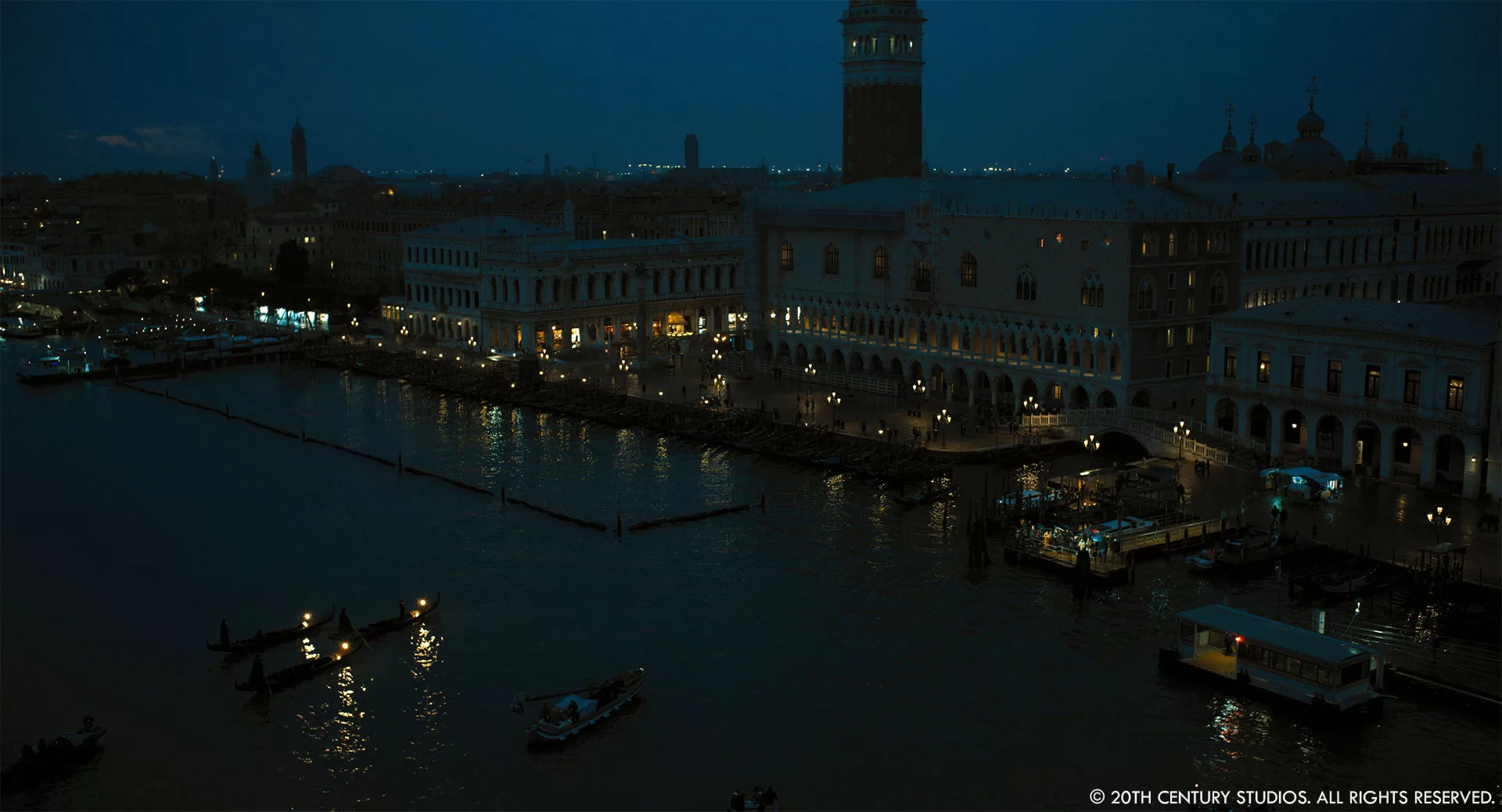
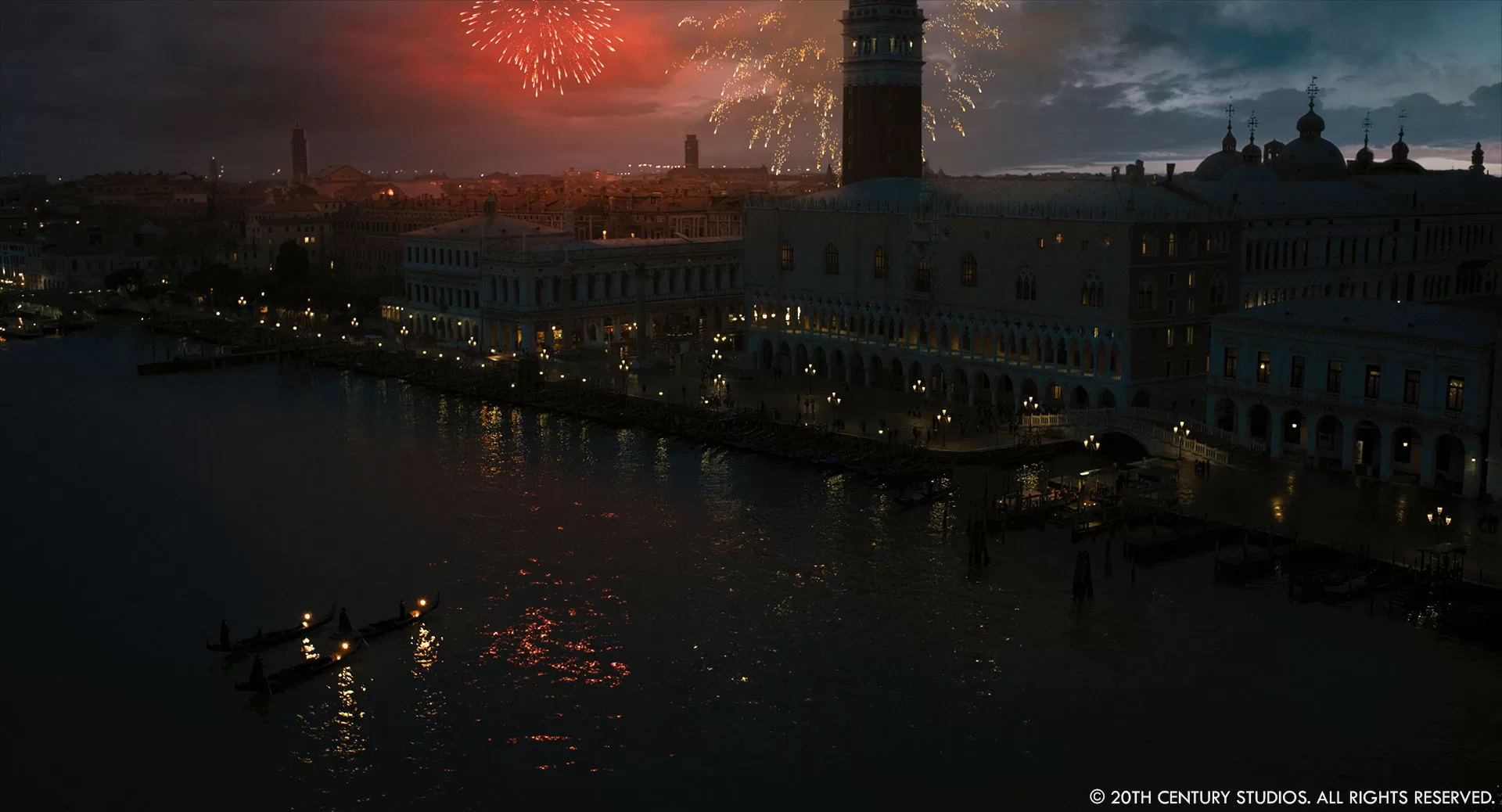
Can you describe a typical day on set and then during the post?
During prep, days involving heavier VFX work had been identified and any extra equipment needed was planned for. So during the shoot, for the most part, it is a case of being on your feet, paying constant attention and keeping your eyes peeled to anything new that comes up and offering quick solutions – for example a quick blue screen that has to go up, or spotting something creeping in shot that shouldn’t be there. Post, in contrast, was far more regimented. The day would involve coming in and viewing any work that had come overnight, spending the morning giving feedback and catching up with the director and editor when possible to present the work, to ask questions, or to catch up on the latest editorial changes.
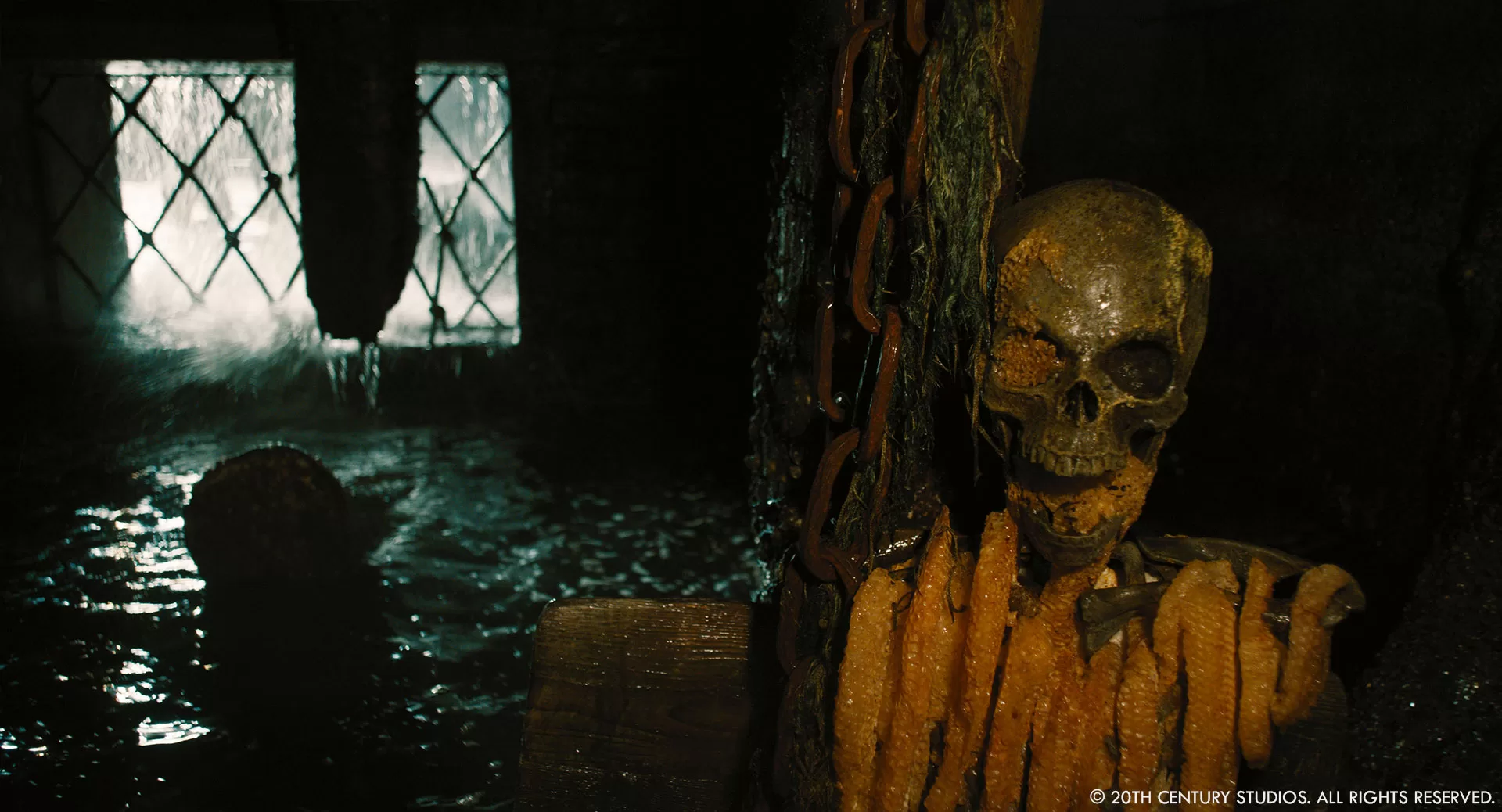
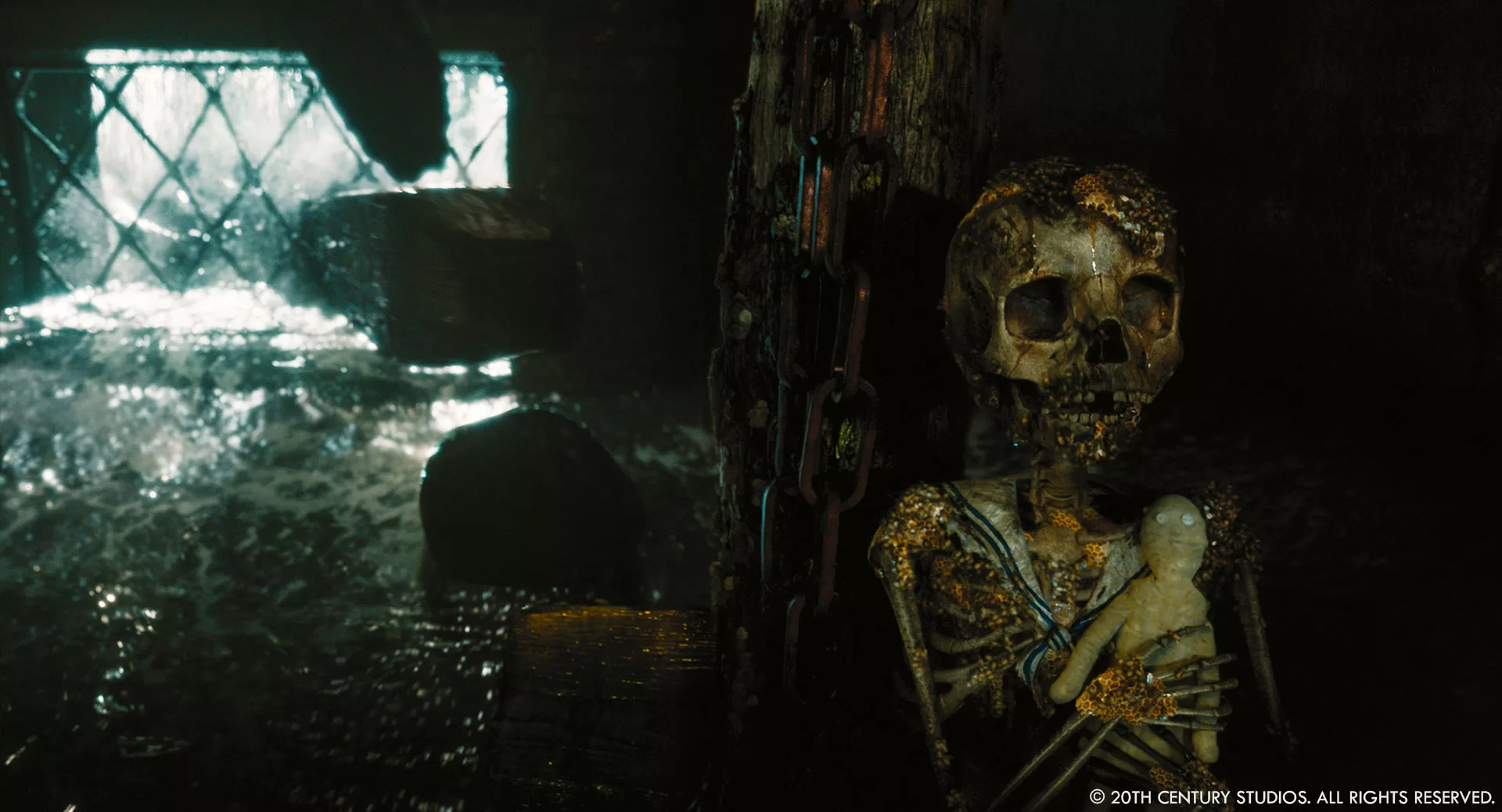
How did you choose and split the work amongst the vendors?
In total, we completed 468 VFX shots on this film. We tried to turnover as quickly as possible after the first director’s cut and Cinesite was always pegged to be the key vendor; more than half of the overall VFX was awarded there. Cinesite was tasked with completing the heavier type of VFX load but with such a tight post-production timeline, more vendors had to join during the last few months and that included two Italian facilities – EDI and Frame by Frame, who did the majority of the clean up and editorial work, and several other smaller facilities who picked up on cosmetic fixes.
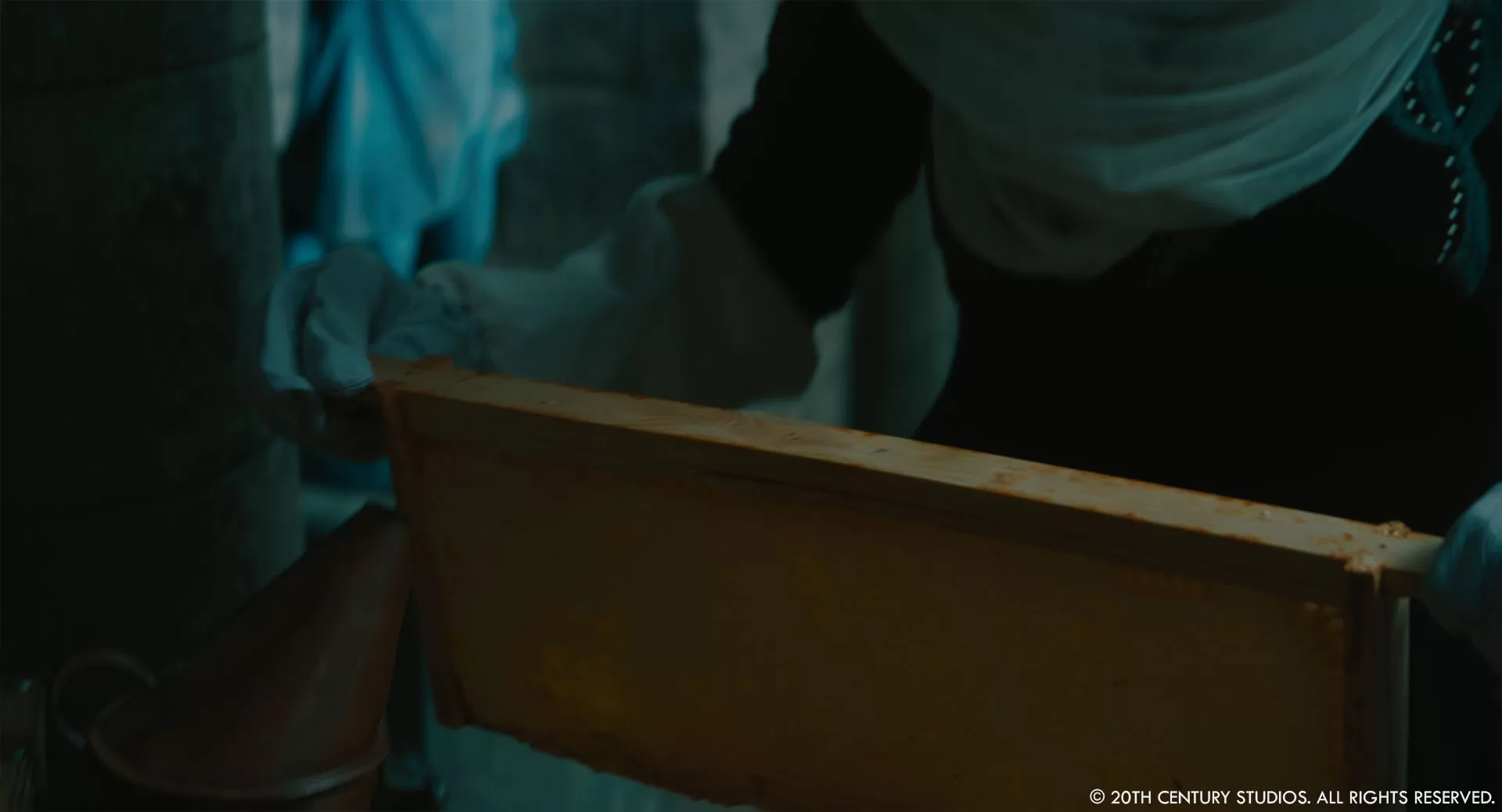
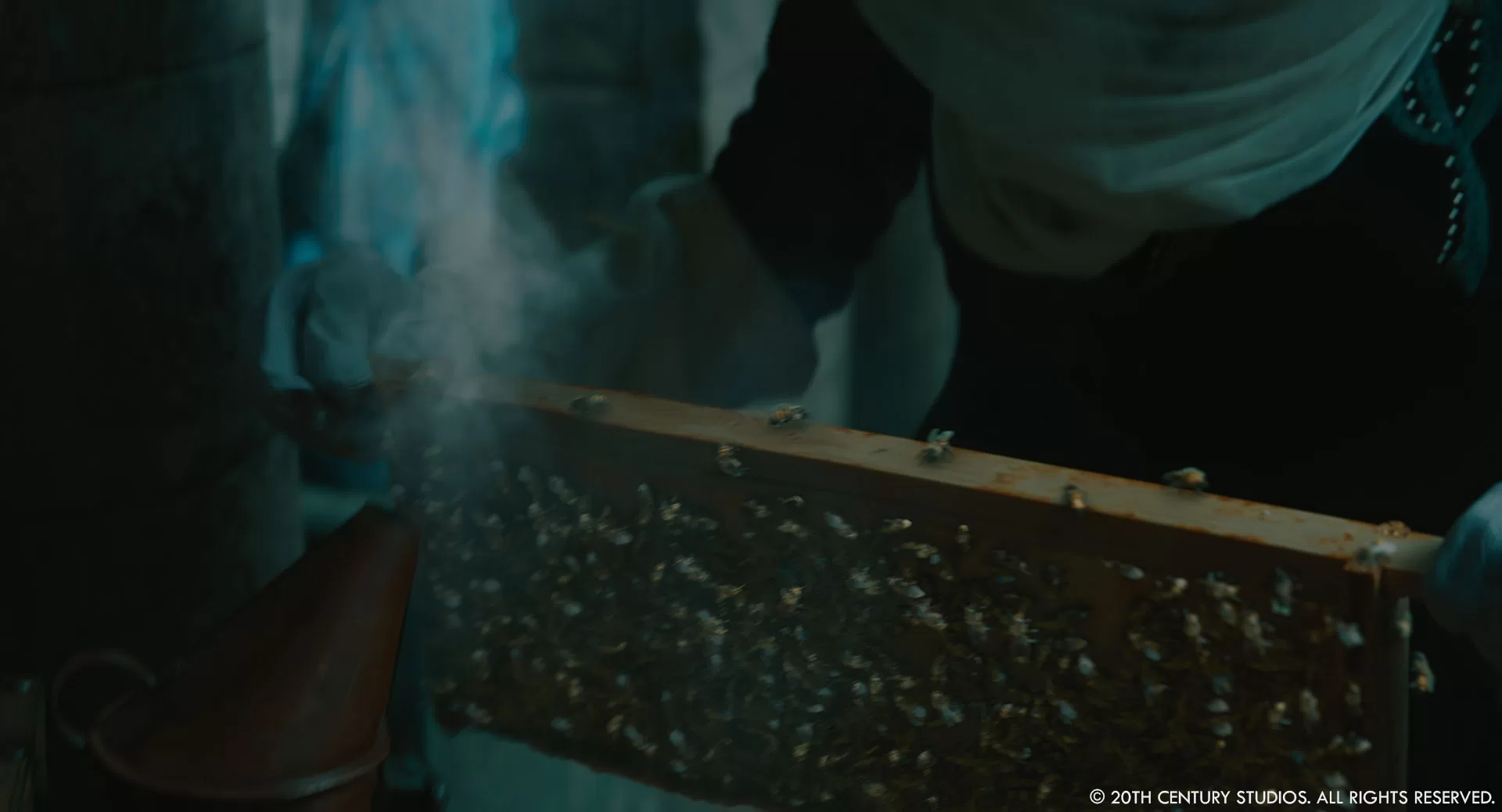
Can you elaborate about the recreation of the period in Venice?
The film is set after World War 2, in 1947, so there was a fair amount of cover-up that we needed to do in Venice. We shot in a variety of different locations, and even though the art department had done a great job of covering as much as possible, the VFX department had to pick up a lot of cleanup and rebuilding of the Venice location shots, especially on the long, wide drone aerials. The main focus was to paint out anything modern – i.e. aerials, PVC windows, advertising posters. There were several landmarks that were covered in construction and we needed to dig through photographs as reference in order to rebuild or replace with something similar, using a combination of CG and DMP. As the Venetian architecture is very special and unique, we had to keep within the realms of the look and feel of the city. There was also the issue of modern boats moving around the canals so we painted out quite a lot of them and we did also shot in Venice right after Xmas, so a few trees and lights also needed to be removed!
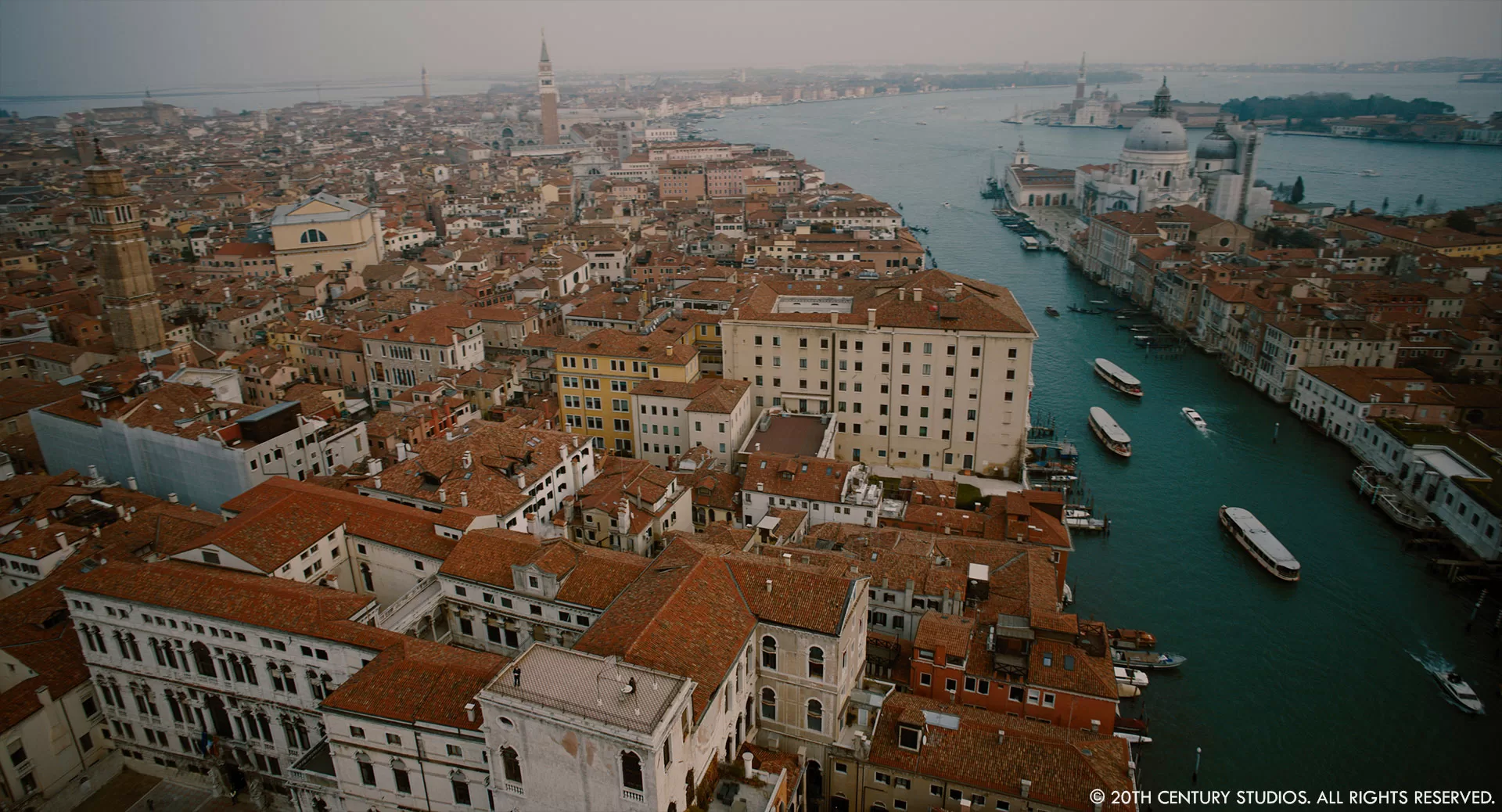
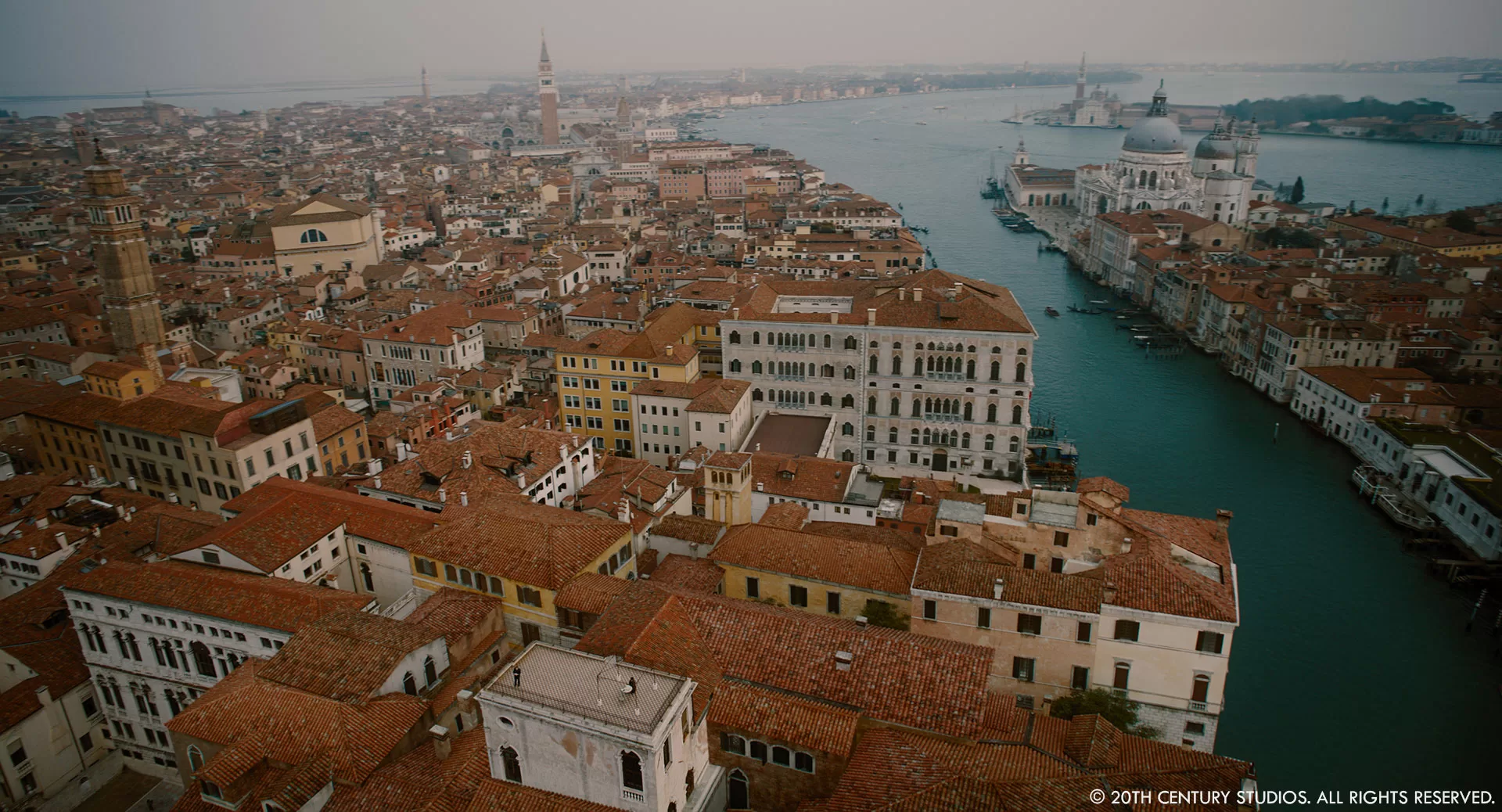
Which location was the most complicated?
The most complicated location in the film was undoubtedly the Palazzo in Venice, where most of the action takes place. This location presented a unique challenge as we needed to seamlessly integrate three different shooting locations into a cohesive whole. We first shot part of its exterior on stage at Pinewood, which required height extensions on certain shots. We then filmed the real Palazzo in Venice on location, and finally, we shot the building as a 1?3 scale miniature. Each of these locations had to blend seamlessly with the others. The miniature primarily required cosmetic fixes and additional rain effects, whereas the exterior shots which we captured in Venice, including the drone footage, required the addition of another CG balcony floor and bell tower, weather effects (such as rain and fog) and the covering up of any modernities and lights.
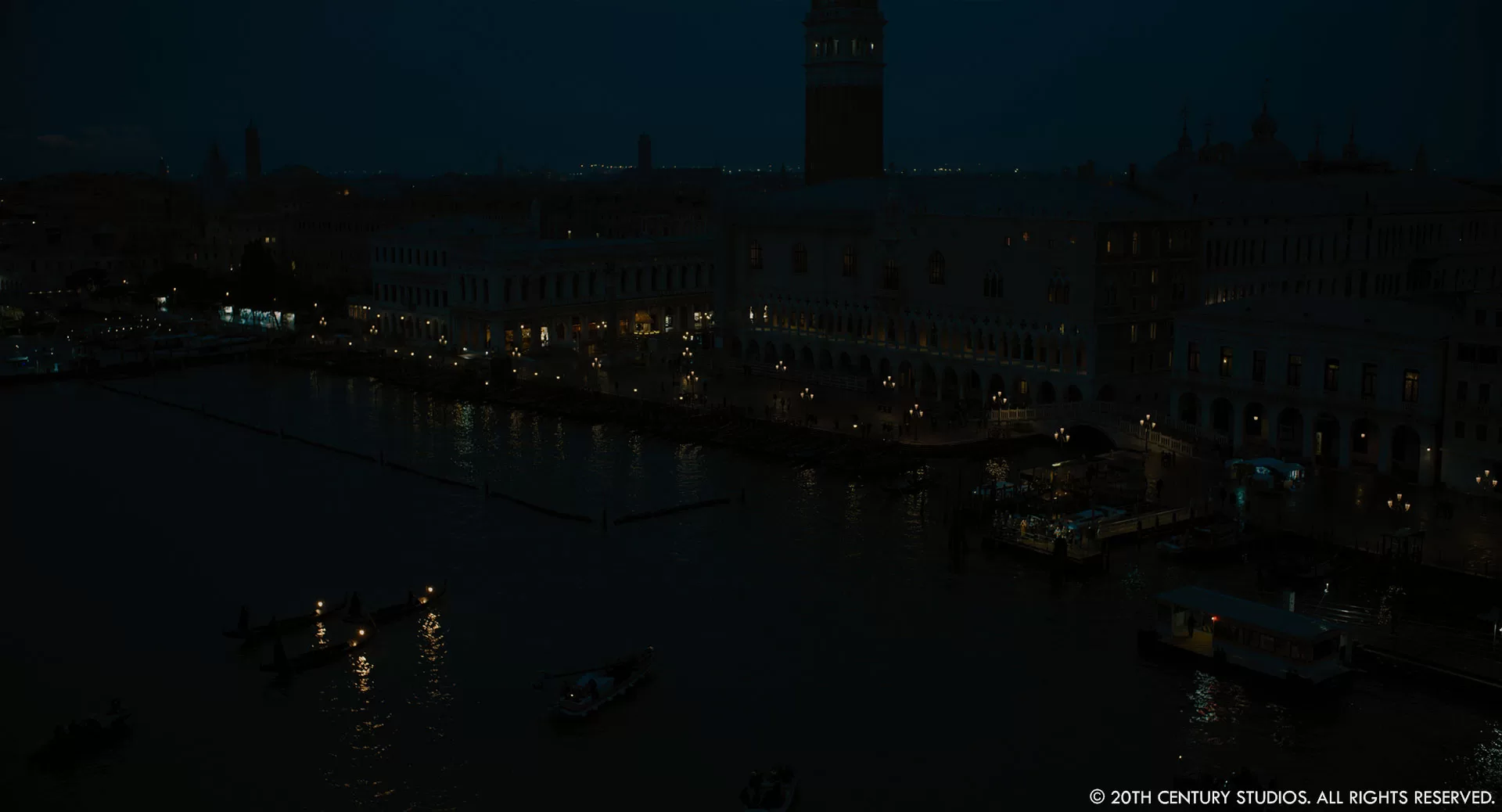
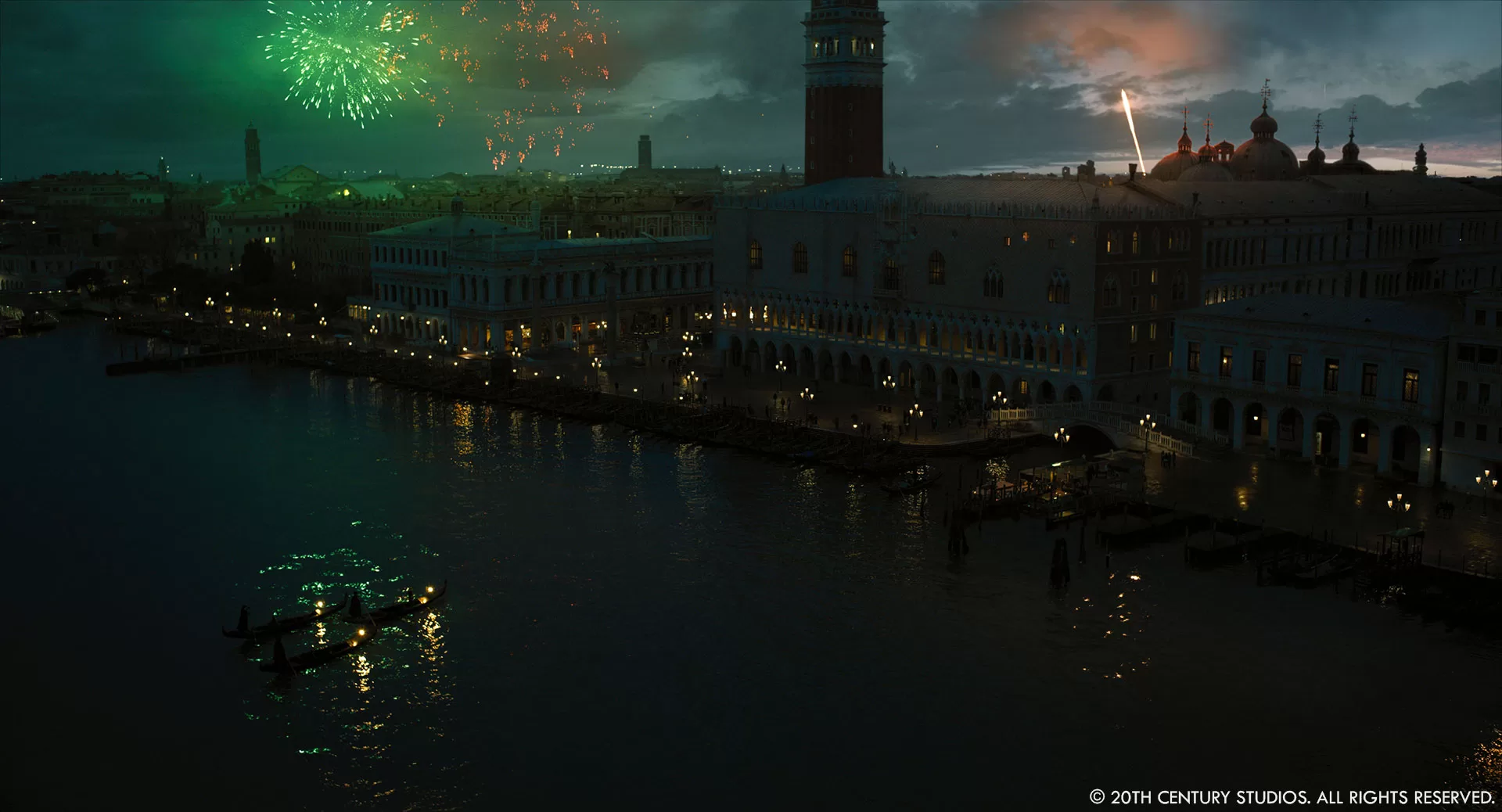
What’s your favourite location in Venice?
We spent a lot of time shooting around the Palazzo Ducale – both inside and around St Mark’s Square, seeing it under different lighting conditions and at different times of the day, like early morning when not many people were about. A lot of those St Mark’s Square shot’s are used in the opening sequence, with the addition of VFX fog, and they are very eerie and atmospheric.
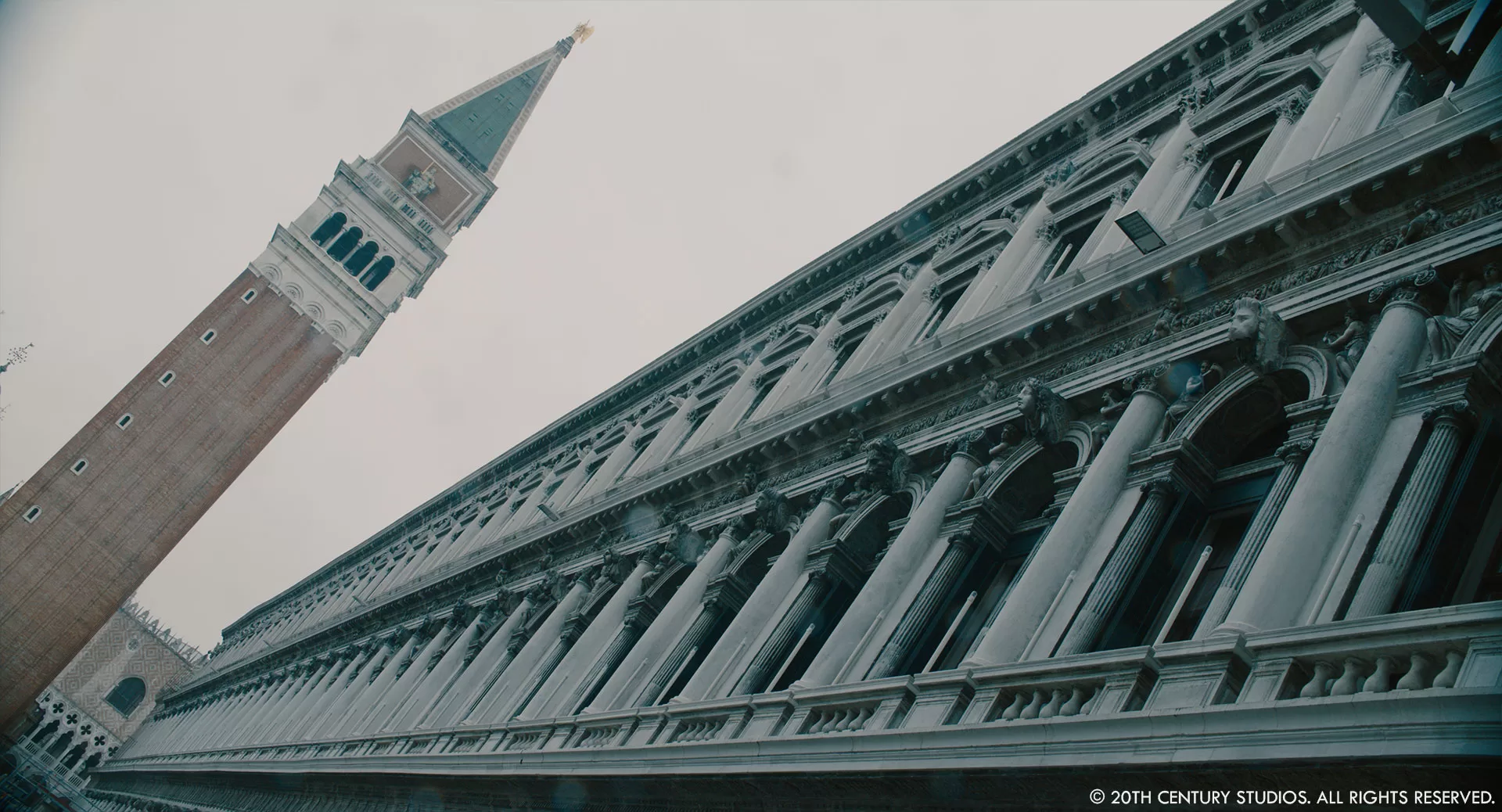
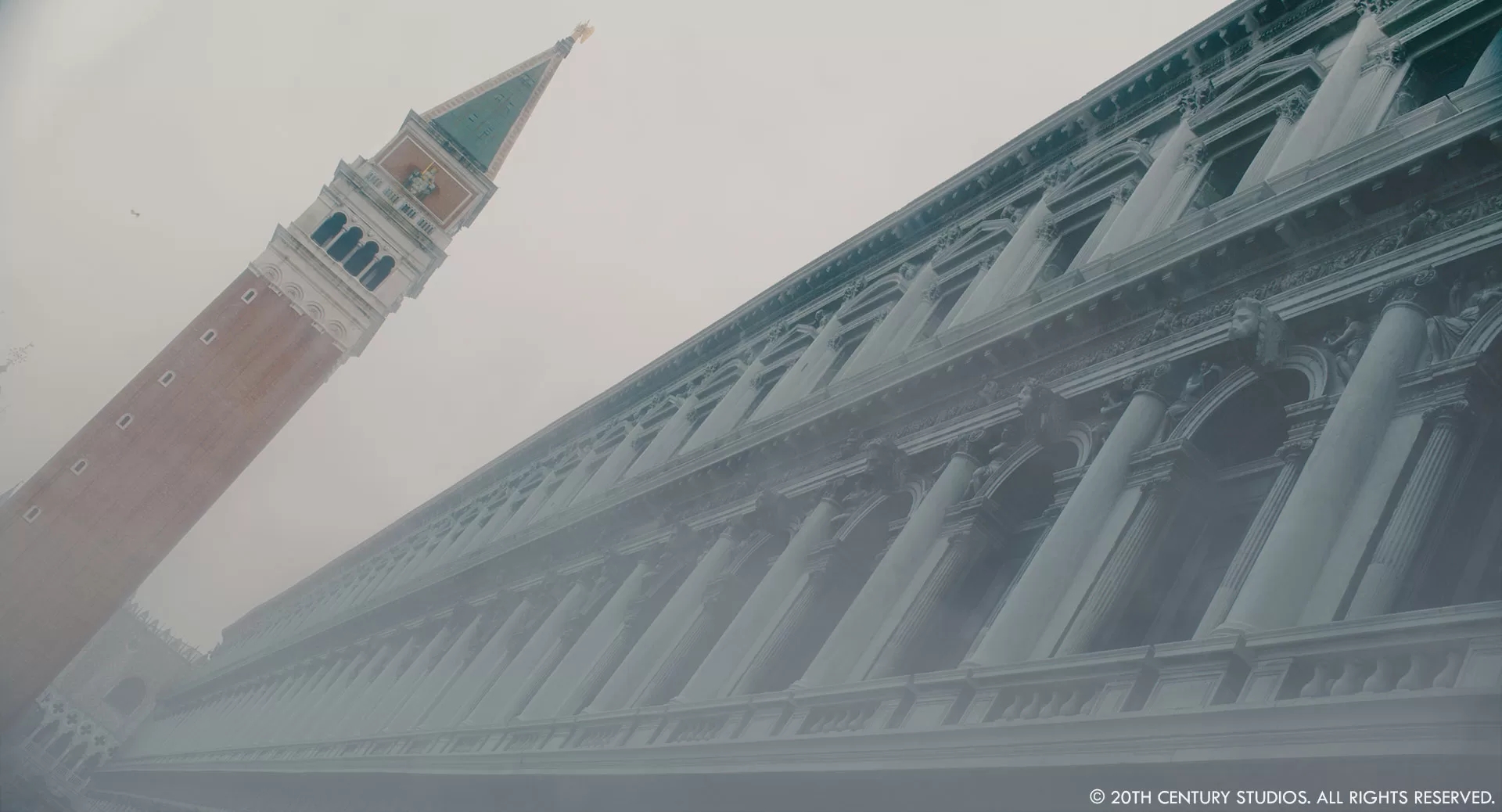
Can you elaborate about the design and creation of the supernatural elements?
There are some key moments in the film when Poirot starts experiencing hallucinations, the nature of which the audience is meant to be unaware of. So the key element was to keep the VFX grounded to reality as much as possible – for example, there is a sequence where Poirot sees cascading water running down a wall that shapes out the letter ‘M’. This needed to feel as real as possible, and having established earlier in the film that the Palazzo was dilapidated and leaking water, we tried to base the look on both of those visual themes.
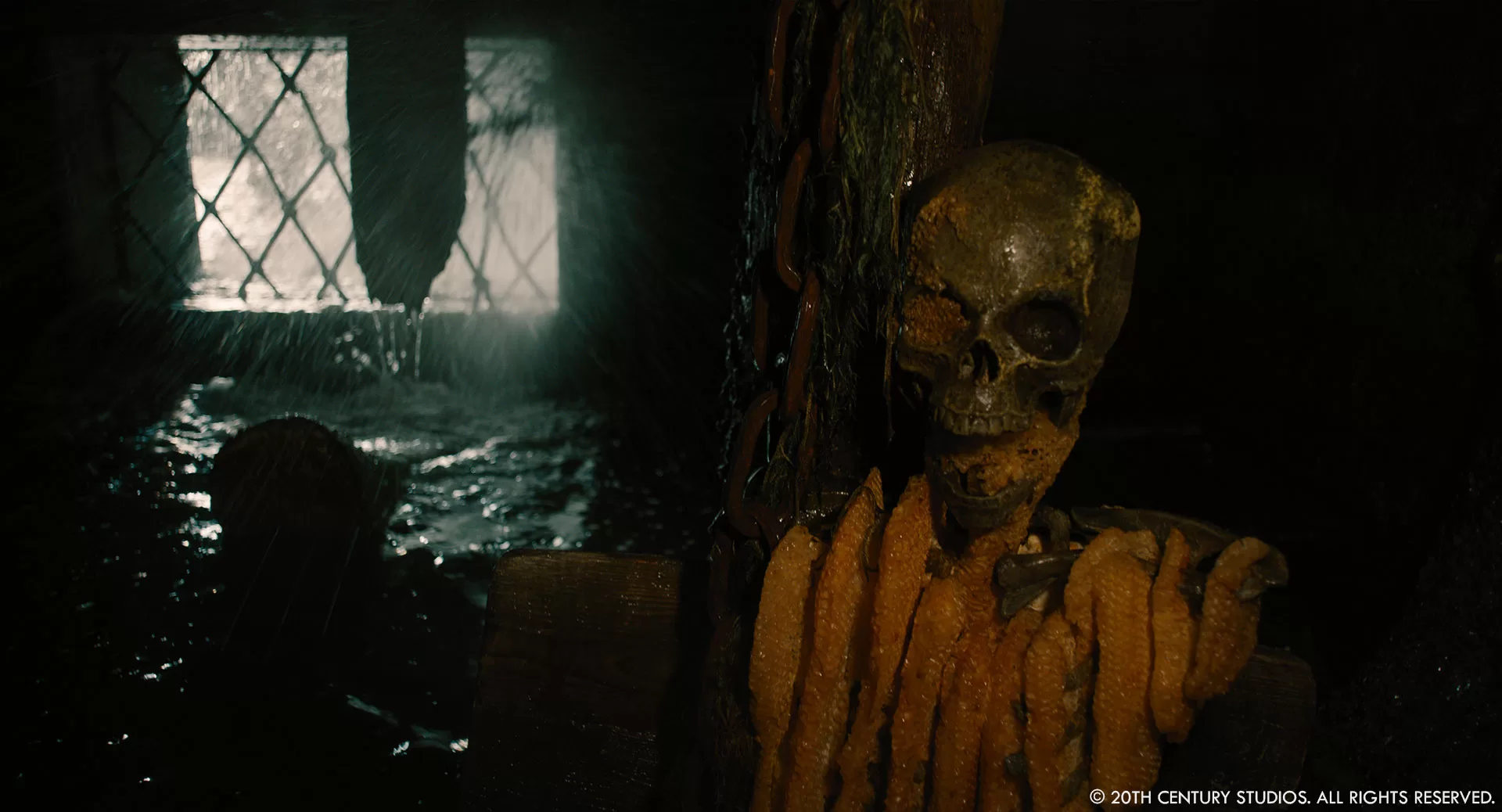
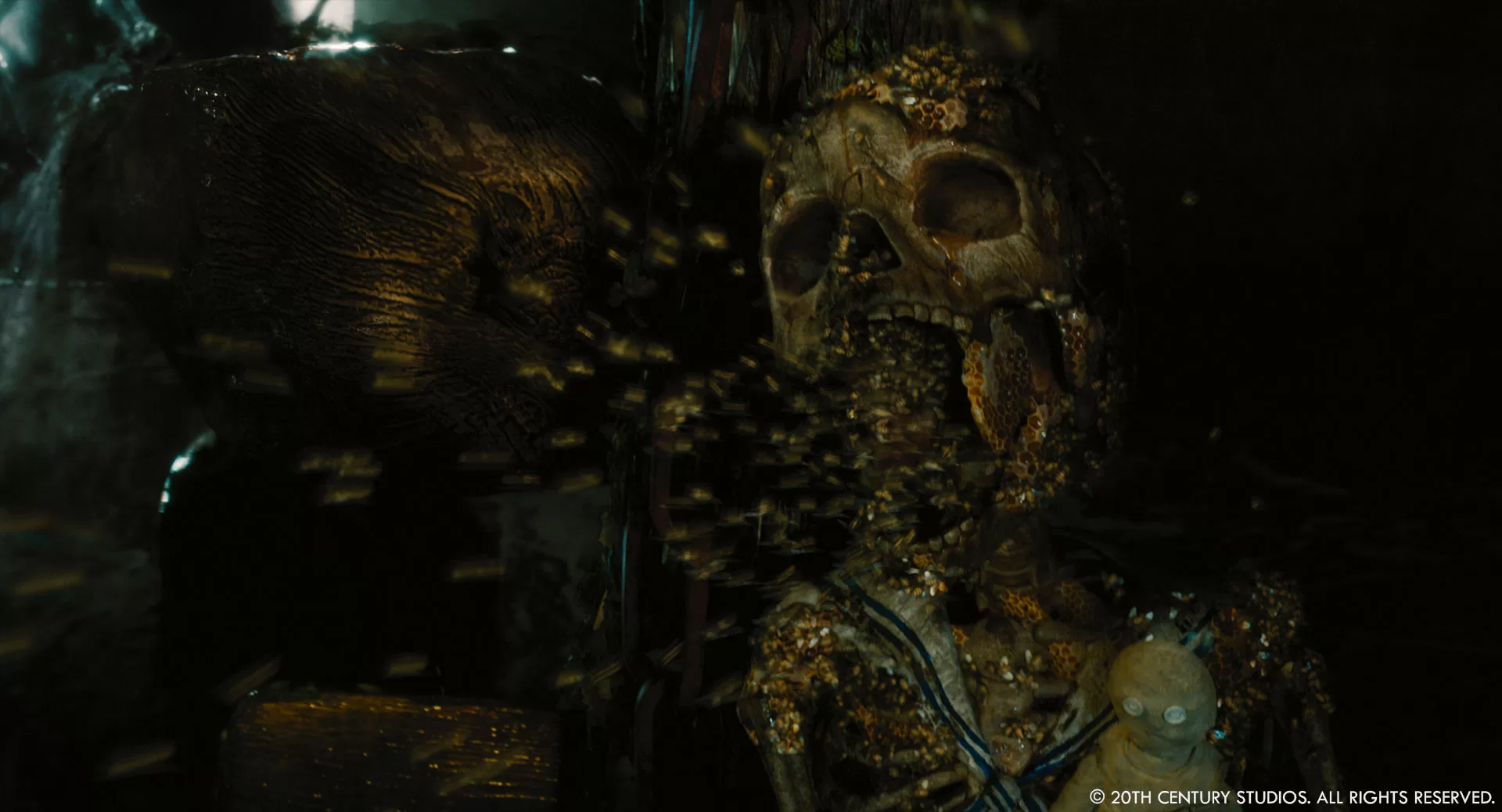
How did you find the balance between supernatural and reality?
Again, the main focus was to base the look of the supernatural firmly on reality. For example, the ghost of Alicia that appears at the end of the film – the director never wanted anything resembling a ghost, such as transparency or a desaturated grade. So we integrated her into the DMP background through the rain as best as possible, while she is floating on wires – which sells the supernatural aspect.
Which sequence or shot was the most challenging?
There are two challenging shots for different reasons – the first is a view in the basement of the Palazzo when Poirot comes across an old skeleton and the second is the final shot of the movie.
For the skeleton shot, we had to create the element of jumpiness and surprise – Poirot discovers a grotesque CG skeleton and CG bees fly out of its gaping mouth, while a wooden CG pole slams into it and disturbs the nest. The design and timing of the shot took a while to get right, as it needed to follow the sequence’s certain tempo of sound and cuts. The design of the skeleton was also important as it needed to look like it had lain forgotten there for many years and it also belonged to a child – something that we showed by the ragged clothes that are still left on the bones and the little doll it’s holding. We had to replace all the water that was shot with CG, to add waves crashing.
The other complicated shot of the film, mainly due to its length of about three minutes, is the final shot of the movie – a drone spiral aerial view, starting close to the characters on a roof terrace and gracefully pulling away to reveal the entire city of Venice. One of the challenges was to remove all traces of modernity, including ongoing construction, from a vast cityscape. Furthermore, the terrace where the two characters stand was not geographically accurate within the story’s context, so we had to rebuild in CG the area around Poirot’s house, and add the terrace on top, ensuring it looked seamless.
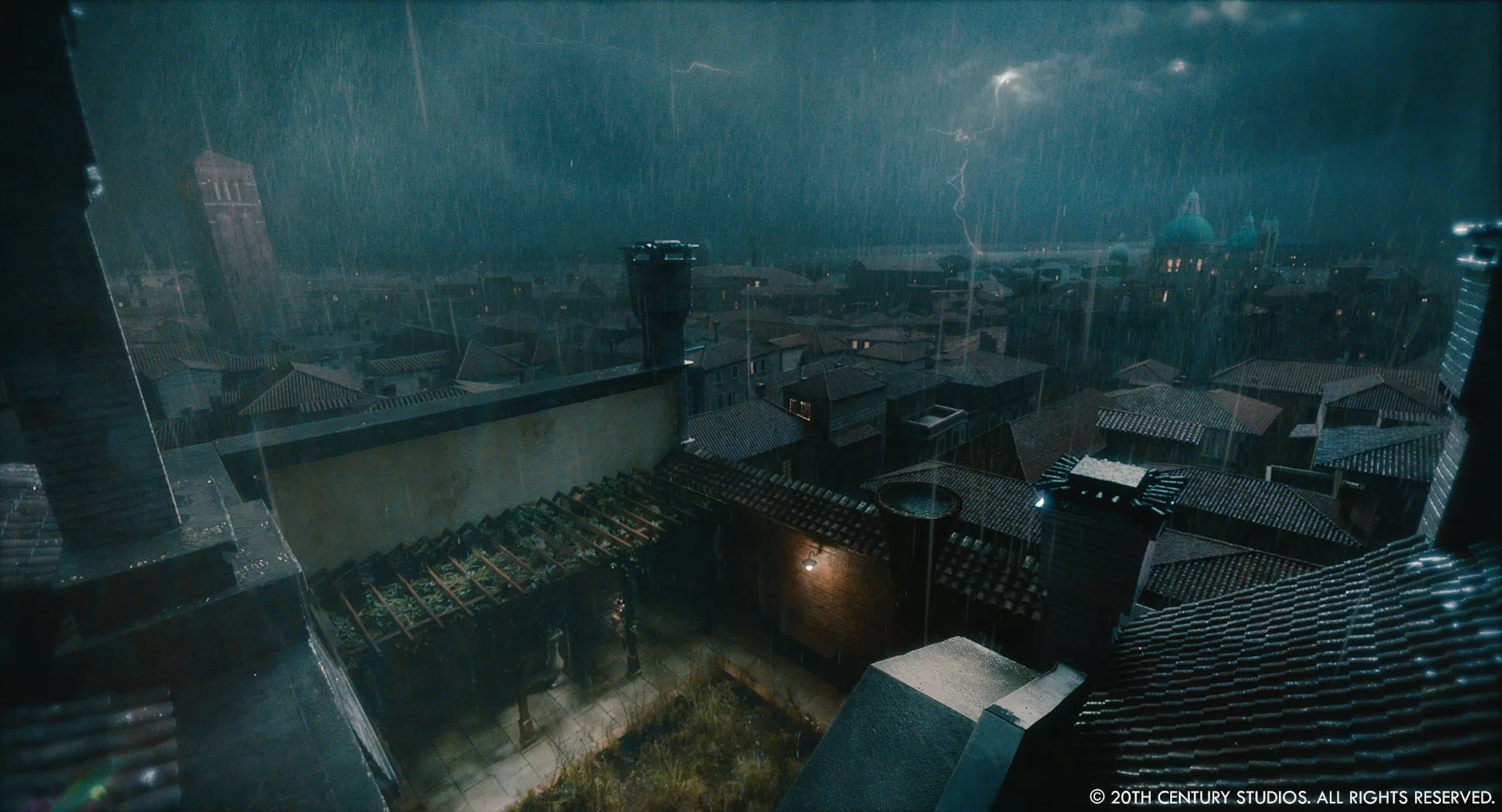
Is there something specific that gives you some really short nights?
VFX wouldn’t be VFX without the stress that comes during the last 2 months of completion – will we hit the deadline? Will the Director be happy? It is tricky at times to explain that VFX takes a while to come through, especially since the work of other departments on a film is more immediate, but you have to try and build trust and assurance to your director that the VFX will come together in the end.
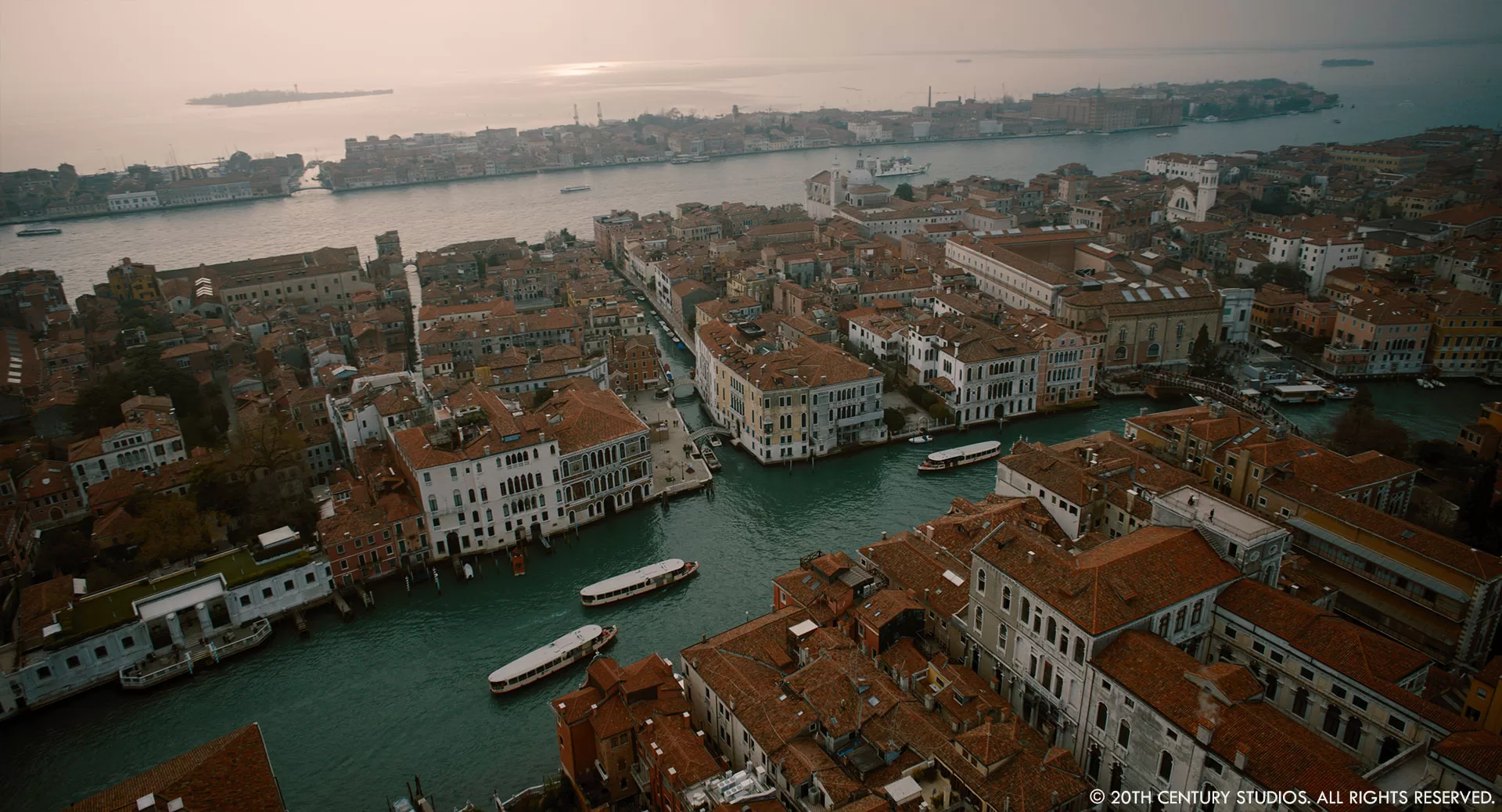
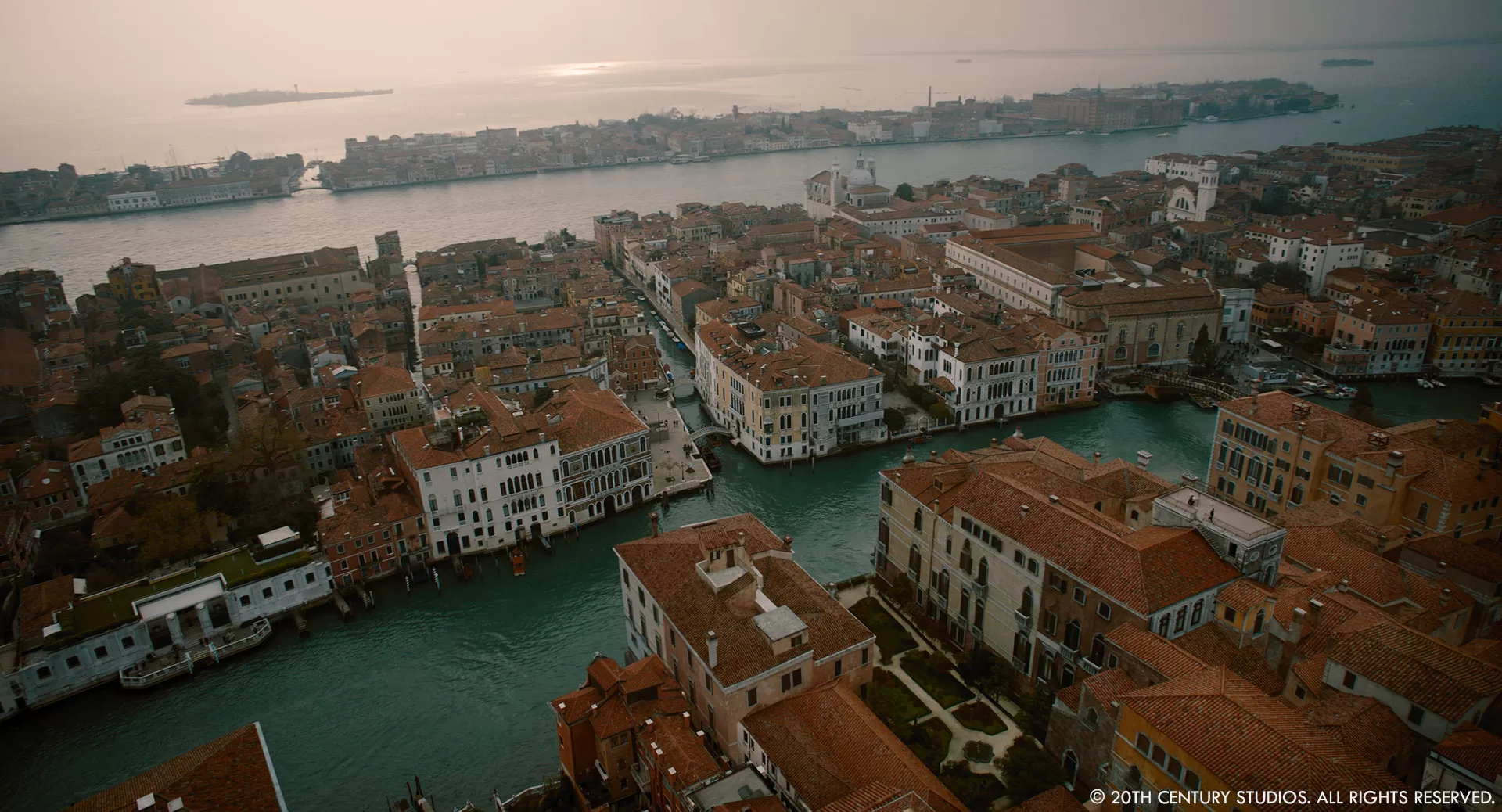
What is your favourite shot or sequence?
Some of my favourite shots in the film are ones where the visual effects, however minimal, seamlessly blend into the scene – enhancing and adding CG rain and creating an atmosphere that is within the realm of the look of the film. There’s a very beautiful shot from the rooftop of the Palazzo on set, looking out over Venice. The camera starts on a CG Venice at night time and a spectacular lightning strike occurs while we tilt down to a CG rooftop extension, combining elements shot on stage with the characters walking out to the terrace. It’s a visually stunning moment that stands out.
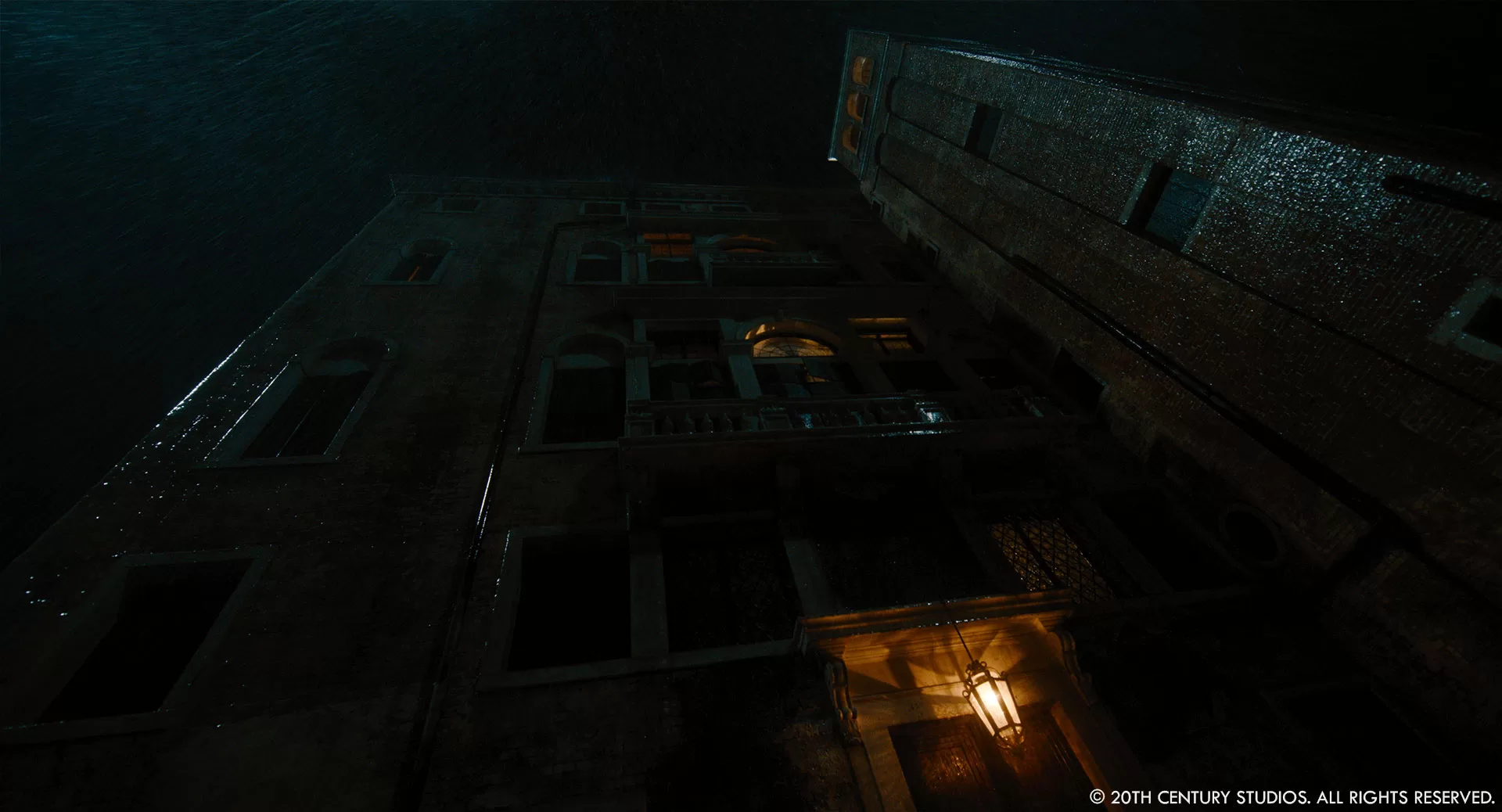
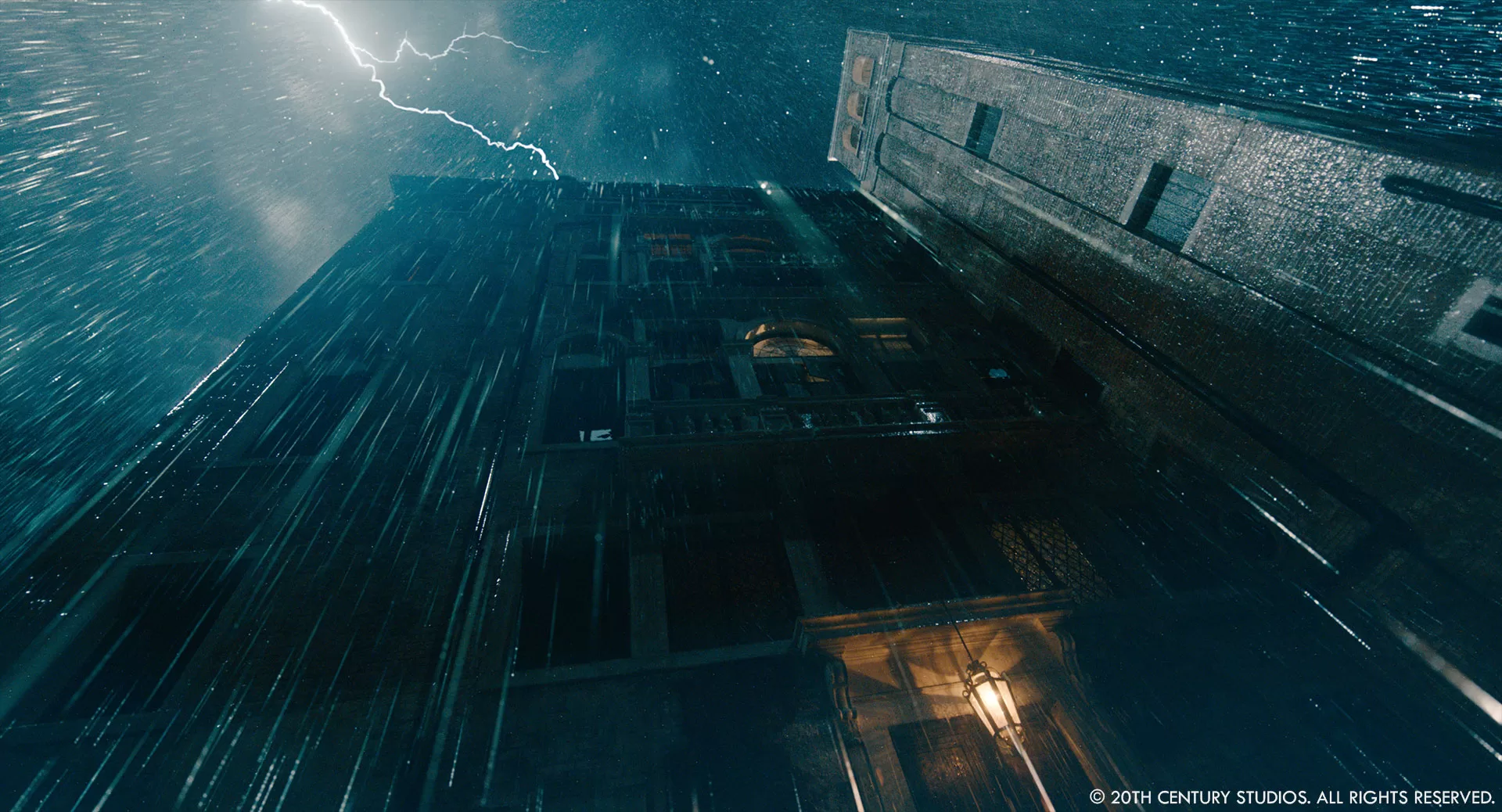
What is your best memory on this show?
During the months of post, I had seen various edits and iterations of the film all with temp sound, VFX and grade. The first time seeing the completed film with all the finished work from every department coming together, that’s when you realise how much you love your job and appreciate being part of something great.
What is your next project?
TBD!
What are the four movies that gave you the passion for cinema?
Very hard to choose just four, as I appreciate many different genres of film. Old Disney animation films, anything late 70s and 80s from Steven Spielberg and any film where you can appreciate great cinematography are all contenders!
A big thanks for your time.
© Vincent Frei – The Art of VFX – 2023






